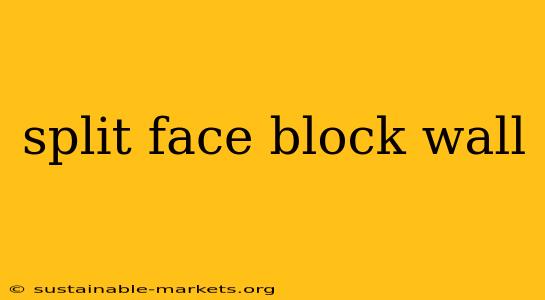Split face block walls offer a unique blend of rustic charm and modern practicality, making them a popular choice for both residential and commercial landscaping projects. Their distinctive texture and varied color palettes add depth and character to any outdoor space. This comprehensive guide delves into everything you need to know about split face block walls, from design considerations to long-term maintenance.
Understanding Split Face Block Walls
Split face blocks are manufactured concrete units designed to mimic the appearance of natural stone. The "split face" refers to the textured, uneven surface created during the manufacturing process, giving each block a unique and visually appealing look. Unlike traditional concrete blocks, their irregular surfaces create shadows and depth, enhancing their aesthetic appeal. They are available in a wide range of colors, sizes, and textures, allowing for extensive design flexibility.
Design Considerations for Your Split Face Block Wall
Before embarking on your project, careful planning is crucial. Consider these key factors:
1. Wall Height and Purpose:
Determine the intended height of your wall. Low retaining walls will have different structural requirements than taller, freestanding walls. The purpose—retaining soil, creating a privacy screen, or purely aesthetic—will also significantly influence the design.
2. Block Selection:
Choosing the right blocks is paramount. Consider:
- Color: Select a color that complements your existing landscaping and home's exterior.
- Texture: The texture can range from subtly rough to dramatically chiseled. Choose a texture that aligns with your desired aesthetic.
- Size and Shape: Different sizes and shapes can create unique visual effects. Larger blocks offer a more modern look, while smaller blocks provide a more rustic feel.
- Durability: Ensure the blocks are suitable for the intended use and local climate conditions. Look for blocks with high compressive strength and freeze-thaw resistance.
3. Foundation and Drainage:
A solid foundation is essential for a stable and long-lasting wall. Proper drainage is equally important to prevent water damage and soil erosion. Consider incorporating a gravel base and drainage channels.
Construction of a Split Face Block Wall: A Step-by-Step Guide
Building a split face block wall involves several key steps:
1. Site Preparation:
Clear the area, excavate the foundation, and level the ground.
2. Foundation Construction:
Pour a concrete footing that extends beyond the width of the wall for stability. Allow sufficient curing time.
3. Block Laying:
Begin laying the blocks, ensuring even spacing and mortar application. Use a level to maintain straightness and plumbness.
4. Mortar Selection:
Choose a high-quality mortar suitable for outdoor use and the climate.
5. Capstones:
Capstones add a finished look and protect the wall from the elements.
6. Finishing Touches:
Grout the joints for a neat and professional finish.
Maintenance of Your Split Face Block Wall
Proper maintenance ensures the longevity and beauty of your wall.
- Regular Cleaning: Clean the wall periodically to remove dirt, debris, and moss. A pressure washer can be effective, but use caution to avoid damaging the blocks.
- Repairing Cracks: Address any cracks promptly to prevent further damage. Use appropriate patching materials.
- Weed Control: Prevent weed growth between blocks by using a weed barrier or herbicide.
- Winter Protection: In colder climates, take measures to protect the wall from freeze-thaw cycles.
Conclusion: The Lasting Appeal of Split Face Block Walls
Split face block walls offer a timeless and versatile solution for a variety of landscaping needs. Their unique aesthetic appeal, coupled with their durability and relative ease of construction, makes them a popular choice for homeowners and landscapers alike. By following this guide, you can successfully plan, construct, and maintain a beautiful and enduring split face block wall that enhances your property for years to come.

